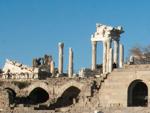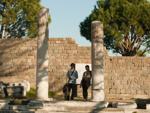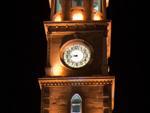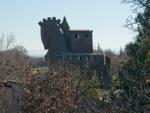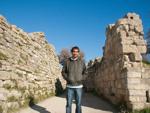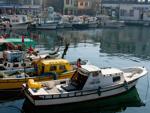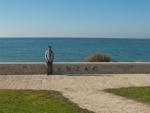My sister Sukey had decided to come and visit us during her uni break so we thought it would be an opportune time to do some more travelling. With Sukey travelling all the way from Perth, we planned to do a trip to Turkey before her stop in Qatar and to save some time we decided we would meet her in Istanbul.
Doha to Istanbul is a short four hour trip. We took Turkish Airlines and it was a pleasant trip – being a red eye flight, I pretty much slept the whole flight. There was a cat in the main cabin which persisted on meowing during the entire trip which was a little bizarre (not that he was meowing – that he was on the flight).
We found a tired Sukey (27 hours of travelling from KL) at the Visa office and picked up our car – a big Renault sedan and headed to Sultanahmet – the area we would be staying for the next three days. As we approached the city area we realised the Renault was probably not the best choice for inner city Istanbul! We managed to find our hostel and settled in just in time for breakfast – the traditional Turkish breakfast of olives, feta cheese, tea (çay), bread, cucumber, tomato and boiled eggs.
Day 1 – Hagia Sophia, Blue Mosque and Grand Bazaar
The morning was spent wandering around Sultanahmet. Right next to the picturesque Sultan Ahmed Mosque (Blue Mosque as it’s commonly known) we decided to walk there first. Being Friday, morning prayers were taking place so we took a few photos and decided to head across to the basilica Hagia Sophia (Aya Sofia in Turkish) only just across from the Mosque. The Hagia Sophia, smaller in size than the Blue Mosque, was completed in 357AD during the Byzantine period and served as a church but since then has been used as a mosque and is now a museum. Interestingly, during the Ottoman period the Hagia Sophia served as a basis for the design of mosques including the Blue Mosque.
Architecturally the Aya Sofiya was amazing – the interior grand with its massive domes and Christian depictions. Inside are also a number of mosaics my favourite being one of the Virgin Mary and her Child, Jesus, flanked by Justinian I who is handing her a model of Hagia Sophia and Constantine I, offering a model of the city, Constantinople.
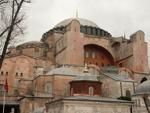


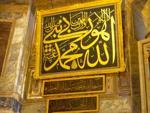



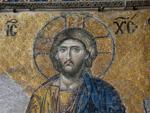







thydzikgooglemap(http://sonyaandtravis.com/maps/turkey-2011-istanbul-hagia-sophia.xml,s)
On our way to the Blue Mosque we sampled the first of our street food. A colourfully dressed street vendor and his stall at Sultanahmet Square were surrounded by men, women, children. Naturally this caught our eye and we wondered what all the fuss was about. Fifteen minutes later Sukey had herself a gooey lollipop on a stick which I thought was a little overrated – but almost every Istanbuli in the area seemed to have one! Outside the mosque we also tried simit (bread) a popular Turkish breakfast. At this point, a Turkish family also asked Sukey and I to take a photo with them!
The Blue Mosque – inside was very, well – mosque like. It is still used as a mosque and there is a women’s area inside as well. Impressive Islamic mosaics – however I much preferred it’s grandness from the outside.










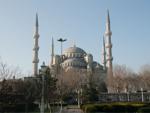




thydzikgooglemap(http://sonyaandtravis.com/maps/turkey-2011-istanbul-blue-mosque.xml,s)
After the mosque we headed towards the Grand Bazaar. What a place! The biggest bazaar/souq I’ve seen – we actually got lost in the place! Hundreds of alleys of jewellery, artwork, ceramic tiles, leather, bags, shoes, it was a shopper’s paradise. My sister and I started making lists in our heads of what we would pick up on the way back…
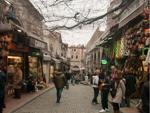











thydzikgooglemap(http://sonyaandtravis.com/maps/turkey-2011-istanbul-grand-bazaar.xml,s)
In the evening we stopped at restaurant (Faros) for some Turkish mezze and dishes – we shared a musakka (eggplant and lamb), cokertme (potatoes, veal and yoghurt) and an eggplant and goats cheese mezze. It was absolutely delicious and we also had a friendly waiter who taught us some of our first Turkish words. On our way back we stopped to admire the splendour of the Hagia Sophia and Blue Mosque at night before heading back to our hostel. Our hostel was right above a quaint restaurant (by the same name) and that night Sukey and I caught up on sisterly gossip over some local Raki (aniseed spirit, similar to Lebanese Arak).
Day 2 – Basilica Cisterns, Topkapi Palace and Spice Markets
We awoke to a beautiful sunny day. Our hostel, Metropolis, was comfortable and we all slept relatively well (except for the noisy Americans next door who left at 5am for a day trip). We walked past the Blue Mosque and Hagia Sophia towards the Basilica Cisterns. After watching From Russia with Love we were keen to see what the ancient underground cistern’s looked like. The cisterns were built in the 6th century under Emperor Justinian’s rule – an ingenious way to store water the city’s water. Quite an eerie place, the water still and deep orange lighting across the 10,000 square metre area. Two pillars stood at the end the very edge of the cistern areas – each with carvings of Medusa’s head (one upside down).



thydzikgooglemap(http://sonyaandtravis.com/maps/turkey-2011-istanbul-basilica-cistern.xml,s)
After the cisterns we headed to the Topkapi Palace, located near the Hagia Sophia. A huge Palace, it was the primary residence of the Ottoman Sultans for over four hundred years. Since the end of the Ottoman Empire it is now a museum. The Palace is enormous – with something like four courtyards. It’s set on a hill and has amazing views of the Bosphorus. Highlights for me included the Spoonmaker’s diamond – 86 carat diamond and the fifth largest in the world. The diamond was actually discovered in the 17th century in a city dump by a local peddler who sold it to a jeweller for a few spoons. Incredibly sparkly, I couldn’t stop staring at it. And of course the famous Topkapi Dagger (from the 1964 film Topkapi) weighted down by a row of three big emeralds and diamonds in the hilt and on the cover. I was expecting to see it on the mannequin of a Sultan, as in the movie but it was not. We also couldn’t take photographs which was a shame.
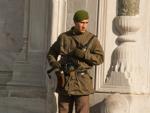














thydzikgooglemap(http://sonyaandtravis.com/maps/turkey-2011-istanbul-topkapi-palace.xml,s)
After Topkapi, we headed for lunch – kebabs on Divan Yolu road, before looking for a Whirling Dervishes ceremony show. We managed to get tickets for the following evening so headed back to the hostel for a rest before heading to the Spice Markets. The Spice Markets were extremely crowded. I have never seen so much Turkish delight, spices and tea in my life. The store vendors here also seemed to be able to say hello in every Asian language so we were Japanese along one aisle and Korean the next. Travis stocked up on Turkish delights and Sukey bought a variety of cheeses, prosciutto and olives. We headed to a small tea stand for Turkish coffee and teas before heading back home.






thydzikgooglemap(http://sonyaandtravis.com/maps/turkey-2011-istanbul-spice-bazaar.xml,s)
That evening we caught a taxi to Beyoğlu which is located on the European side of Turkey, but on the north part of the Golden Horn. Beyoğlu is famous for its restaurants and mayhenes (local Turkish pubs and bars). As it was Saturday night the streets were packed with locals. We had dinner – a selection of mezze and some red wine before heading to a local bar for some music and dancing.
Day 3 – Chora Church, Yedikule Fortress and Whirling Dervishes
The following day we decided to check out some sites in Western Istanbul. First the Chora Church – a church from the Byzantine period (which was also converted in to a mosque during the 16th century Ottoman rule). Most of the Christian mosaics are still relatively intact and tell stories of the lives of Mary and Jesus.




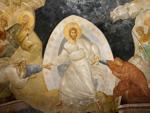



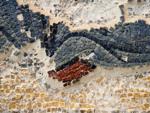
thydzikgooglemap(http://sonyaandtravis.com/maps/turkey-2011-istanbul-chora-church.xml,s)
After this, we went to the Golden Gate and the Yedikule Fortress, part of the Walls of Constantinople which are made of stone.






thydzikgooglemap(http://sonyaandtravis.com/maps/turkey-2011-istanbul-yedikule-fortress.xml,s)
We headed back to the hostel and rested before heading to the Whirling Dervishes ceremony. The Whirling Ceremony is a religious one of the Mevlevi order (Sufi) and traditionally from Konya in central Turkey. However it has spread to Istanbul and a few places allow visitors to attend and watch the ceremony. The first part of the ceremony was a traditional musical concert and the second, the Whirling Ceremony. Five semazens entered the round stage and for a good hour, whirled in their white costumes – their faces in a trance-like state and their arms in the air. It was quite amazing to watch. I think Travis was disappointed we weren’t allowed to take photos, despite the tour booking guide clarifying that we could.
We headed back and rested for our early morning wake up the following day – next stop, Gallipoli.















































































































